
Introduction
Athens, the cradle of Western civilization and one of the oldest cities in the world offers a captivating blend of ancient history, vibrant culture, and modern charm. Nestled against the backdrop of the Acropolis, Athens boasts a rich tapestry of archaeological wonders, from iconic landmarks like the Parthenon to labyrinthine streets lined with neoclassical buildings. As the birthplace of democracy, philosophy, and theatre, Athens exudes a sense of grandeur and significance that resonates throughout its ancient ruins and cultural heritage. Visitors to Athens can immerse themselves in millennia of history while exploring archaeological sites, museums, and bustling neighbourhoods, making it a destination that beckons to history enthusiasts and curious travellers alike.
The allure of Athens lies not only in its historical significance but also in its dynamic energy and vibrant atmosphere. Modern Athens pulsates with life, from bustling markets and lively tavernas to contemporary art galleries and trendy neighbourhoods. Visitors can wander through the narrow streets of Plaka, savouring the aromas of Greek cuisine and admiring the colourful bougainvillaea that adorn the whitewashed buildings. Meanwhile, the city’s vibrant street art scene and eclectic nightlife offer a glimpse into its thriving cultural landscape. With its juxtaposition of ancient wonders and modern delights, Athens presents an irresistible blend of past and present, making it an exciting and enchanting destination for travellers seeking to delve into the heart of Greek history and culture.
Table of Contents
Map of the Best Things to Do in Athens
The Acropolis and Parthenon
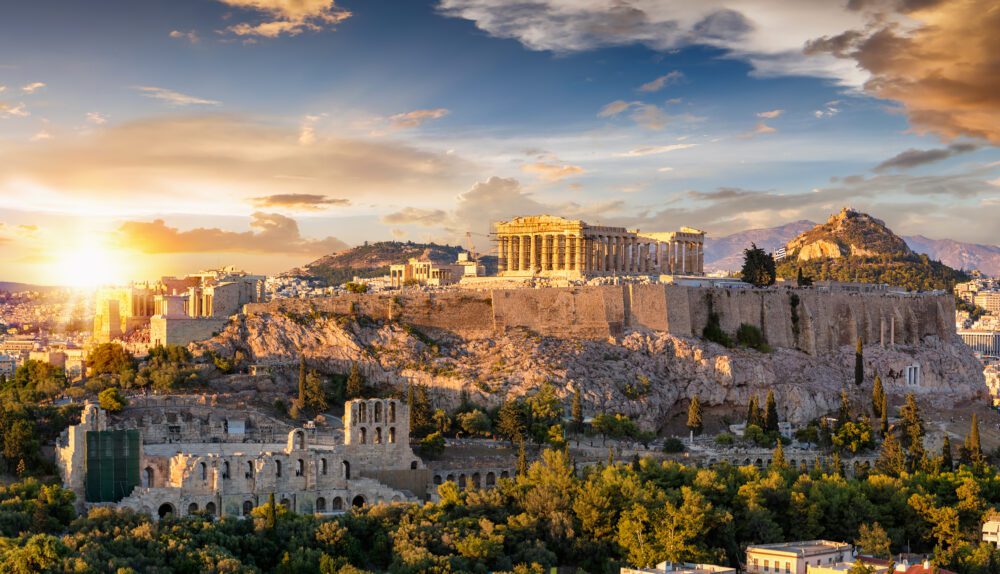
Perched atop a rocky outcrop overlooking Athens, the Acropolis stands as a timeless symbol of ancient Greek civilization and architectural mastery. Dating back to the 5th century BC, this UNESCO World Heritage Site is home to several majestic structures, with the Parthenon reigning supreme as its most iconic monument. Dedicated to the goddess Athena, the Parthenon is a marvel of Doric architecture, renowned for its symmetrical design, intricate marble carvings, and towering columns. Despite centuries of weathering and partial destruction, the Parthenon remains a testament to the enduring legacy of ancient Greece, inspiring awe and admiration in visitors from around the world.
Visiting the Acropolis and Parthenon is an essential experience for anyone exploring Athens. To make the most of your visit, it’s advisable to arrive early in the morning to beat the crowds and the heat, especially during the peak tourist season. Wear comfortable shoes as you navigate the uneven terrain and steep paths leading up to the Acropolis. Once there, take your time to soak in the breathtaking views of the city below and marvel at the architectural wonders that have stood the test of time. Consider hiring a licensed guide or joining a guided tour to gain deeper insights into the history and significance of the Acropolis and its monuments.
The Odeon of Herodes Atticus
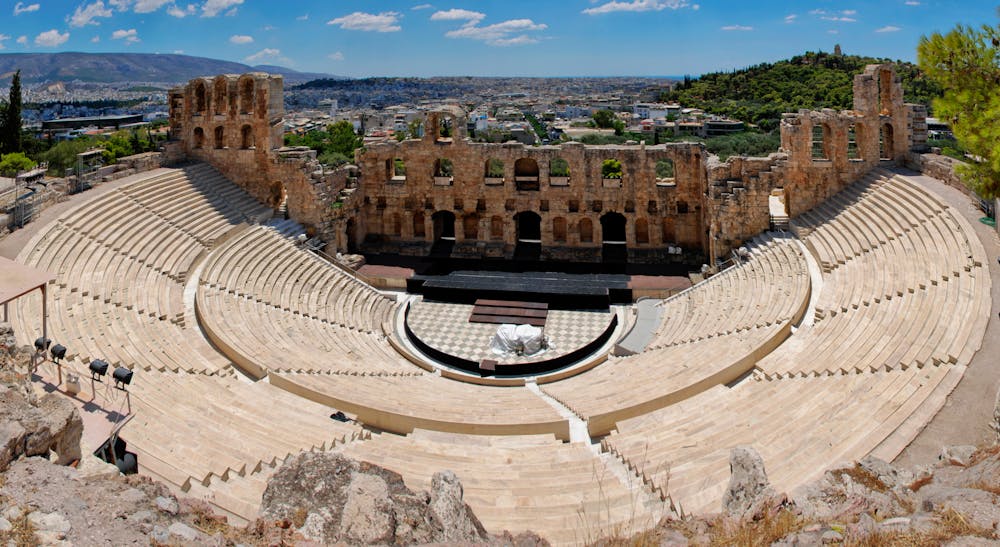
Nestled at the foot of the Acropolis, the Odeon of Herodes Atticus is a stunning ancient amphitheatre that has played a significant role in the cultural history of Athens. Constructed in 161 AD by Herodes Atticus, a wealthy Athenian benefactor, the odeon was initially used for musical performances and other cultural events. With its imposing stone arches and the magnificent backdrop of the Acropolis, the theatre provided a spectacular venue for artistic expression and entertainment. Despite suffering damage over the centuries, including destruction during invasions and wars, the Odeon of Herodes Atticus was meticulously restored in the 1950s and continues to host concerts, theatrical performances, and cultural events to this day.
Visiting the Odeon of Herodes Atticus offers a unique opportunity to immerse yourself in the rich history and cultural heritage of Athens. The theatre’s breathtaking setting and superb acoustics make it an unforgettable venue for experiencing live performances, especially during the Athens Festival held annually from May to October. When planning your visit, be sure to check the event schedule in advance and book tickets for any performances you wish to attend. Arrive early to explore the surrounding area and enjoy panoramic views of the Acropolis before the show begins. Additionally, consider joining a guided tour to learn more about the history and significance of this ancient landmark.
Ancient Agora of Athens
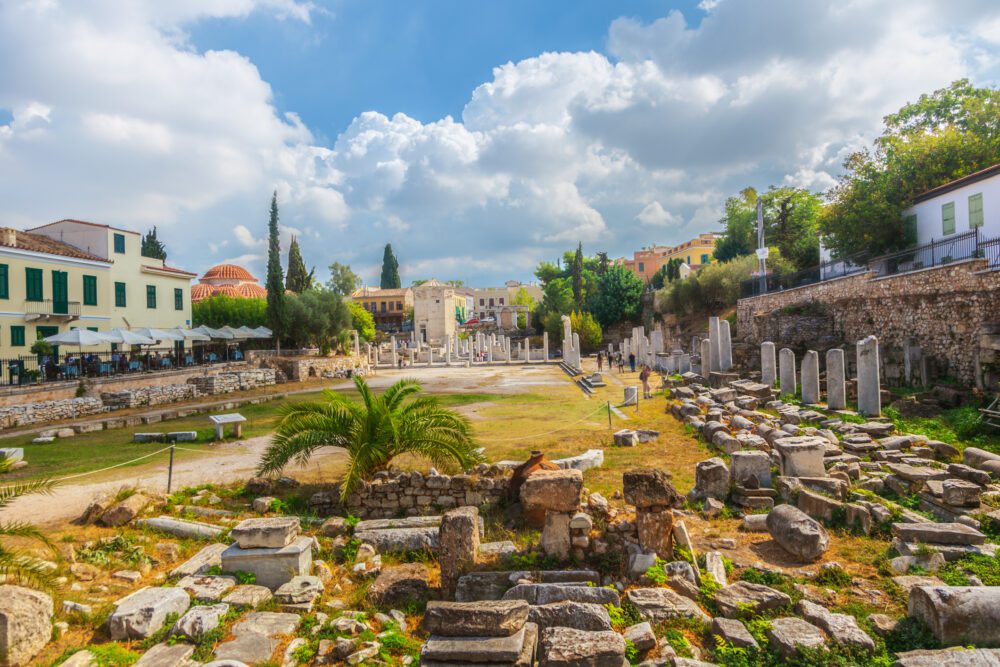
The Ancient Agora of Athens, located northwest of the Acropolis, served as the heart of ancient Athens’ civic life and marketplace. Dating back to the 6th century BC, this vast archaeological site was not only a bustling marketplace but also the centre of political, commercial, and social activity in ancient Athens. Here, Athenian citizens gathered to engage in political discussions, trade goods, and participate in religious ceremonies. The site is home to several well-preserved ruins, including the Temple of Hephaestus, one of the best-preserved ancient Greek temples. Visitors can explore the remnants of ancient buildings, walk along ancient streets, and marvel at the architectural wonders that once defined the agora.
When visiting the Ancient Agora, it’s advisable to set aside ample time to fully explore the site and soak in its historical significance. Consider joining a guided tour to gain insights into the rich history and cultural importance of this ancient site. Don’t miss the opportunity to visit the Stoa of Attalos, a reconstructed ancient building that now houses the Museum of the Ancient Agora, where artefacts and exhibits offer further insights into daily life in ancient Athens. Additionally, take some time to relax and enjoy the peaceful surroundings of the agora, surrounded by towering ancient ruins and lush greenery.
Monastiraki Neighbourhood
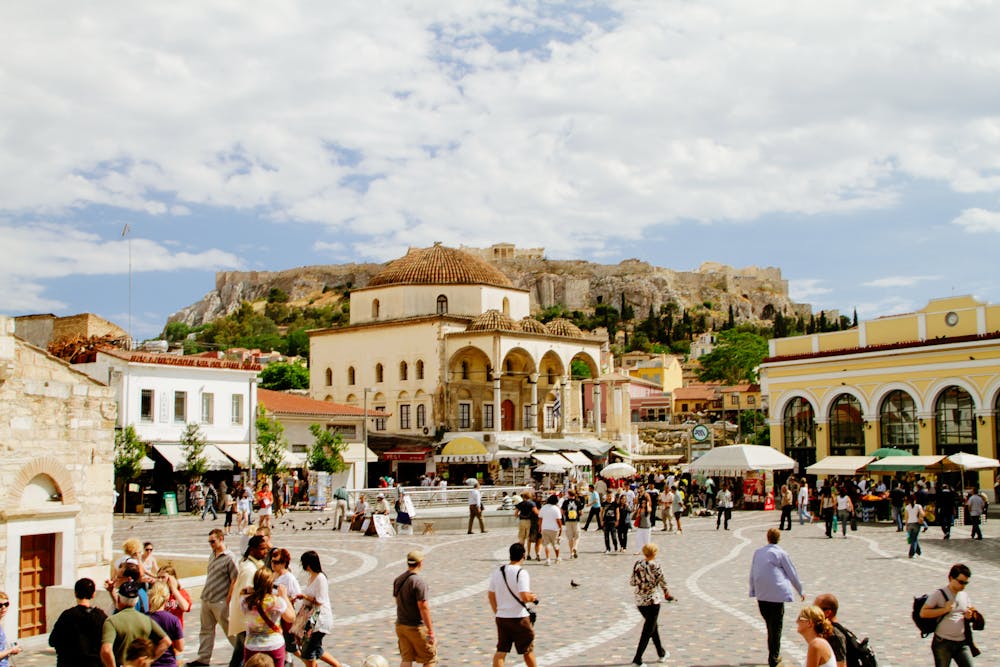
Monastiraki is a vibrant neighbourhood located northwest of the Acropolis in Athens, Greece. Its name, which means “small monastery” in Greek, derives from the Monastery of Pantanassa, a Byzantine-era monastery that once stood in the area. Today, Monastiraki is known for its bustling flea market, lively atmosphere, and eclectic mix of shops, cafes, and restaurants. Visitors flock to the area to explore its narrow cobblestone streets, browse through antique shops and artisanal boutiques, and sample delicious Greek street food. The focal point of Monastiraki is the Monastiraki Square, where the remnants of the Hadrian’s Library and the Tzistarakis Mosque stand as reminders of the neighbourhood’s rich history and cultural heritage.
Exploring Monastiraki is a delight for shoppers and food enthusiasts alike. The flea market, which operates daily, offers a wide array of goods, including vintage clothing, jewellery, souvenirs, and traditional Greek products. Visitors can haggle with vendors to snag unique items and treasures to take home as mementoes of their trip to Athens. After browsing through the market stalls, travellers can relax at one of the many cafes or tavernas lining the streets of Monastiraki and enjoy traditional Greek cuisine while soaking in the vibrant atmosphere. For panoramic views of the city and the Acropolis, head to one of the rooftop bars or restaurants in the area, where you can sip on a refreshing drink while taking in the breathtaking sights of Athens.
Plaka Neighbourhood
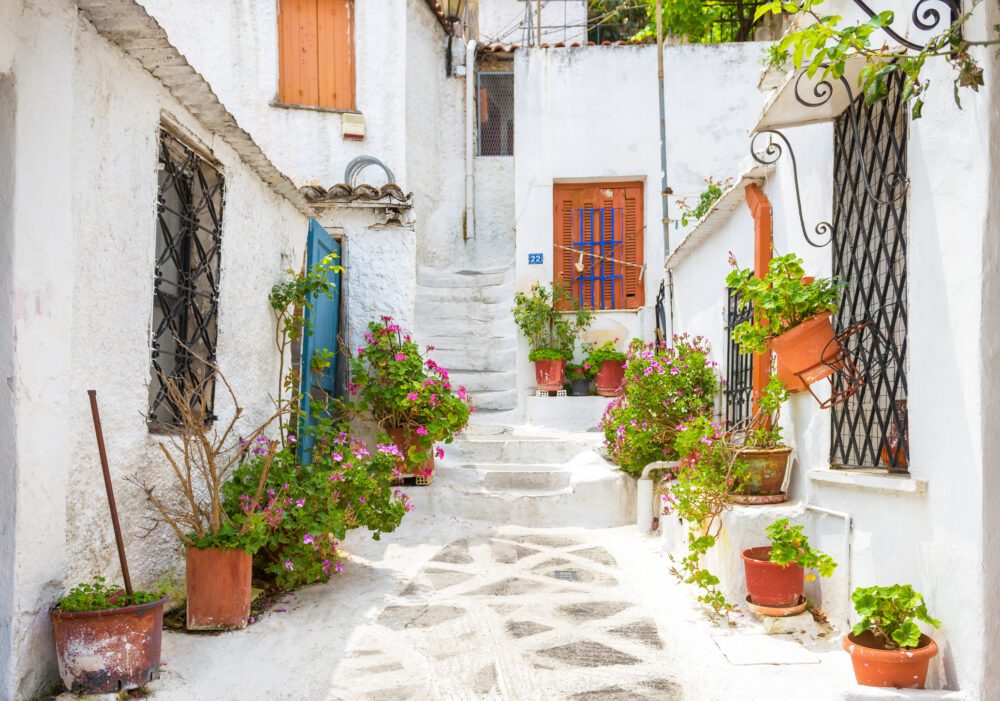
Plaka, often referred to as the “Neighborhood of the Gods,” is one of the oldest and most picturesque neighbourhoods in Athens, Greece. Situated just below the Acropolis, Plaka boasts a rich history that dates back thousands of years. In ancient times, Plaka was the residential area for the city’s aristocrats and politicians, and remnants of its illustrious past can still be seen today in its narrow cobblestone streets, neoclassical mansions, and Byzantine churches. Visitors to Plaka can wander through its charming alleys, marvel at the architectural wonders, and discover hidden gems around every corner. One of the highlights of Plaka is the Anafiotika neighbourhood, a small enclave nestled within Plaka’s winding streets, known for its whitewashed houses and stunning views of the Acropolis.
Exploring Plaka is like stepping back in time, with its labyrinthine streets and well-preserved historical buildings. Travelers can immerse themselves in the neighborhood’s vibrant atmosphere by visiting its numerous shops, cafes, and tavernas. Plaka is renowned for its souvenir shops, where visitors can find a variety of traditional Greek handicrafts, jewellery, and souvenirs to take home as keepsakes. Additionally, Plaka is home to some of the best restaurants in Athens, serving up delicious Greek cuisine and offering al fresco dining experiences with breathtaking views of the Acropolis. For those interested in history and culture, Plaka is also home to several museums and archaeological sites, including the Museum of Greek Folk Musical Instruments and the Roman Agora, making it a must-visit destination for anyone exploring Athens.
Temple of Olympian Zeus

The Temple of Olympian Zeus, also known as the Olympieion, is one of the most significant ancient temples in Athens, Greece. Built over several centuries, construction of the temple began in the 6th century BC during the rule of the Athenian tyrants and was completed in the 2nd century AD during the Roman period. Dedicated to Zeus, the king of the Olympian gods, the temple was designed to be one of the largest in the ancient world, boasting 104 Corinthian columns, of which only a few remain standing today. The grandiosity of the temple was a testament to the power and wealth of ancient Athens. Visitors to the Temple of Olympian Zeus can admire the remaining columns, which provide a glimpse into the scale and magnificence of the original structure. Adjacent to the temple, visitors can also see the colossal fallen columns, including the famous Column of Olympian Zeus, which toppled during a storm in the 19th century.
Practical tips for visiting the Temple of Olympian Zeus include wearing comfortable walking shoes, as the site requires some walking, and bringing along plenty of water, especially during the hot summer months. It’s also advisable to visit early in the morning or late in the afternoon to avoid the crowds and the heat. While exploring the site, visitors can take advantage of guided tours or audio guides to learn more about the history and significance of the temple. Additionally, the nearby Arch of Hadrian and the National Garden are worth exploring as part of the same visit.
Panathenaic Stadium
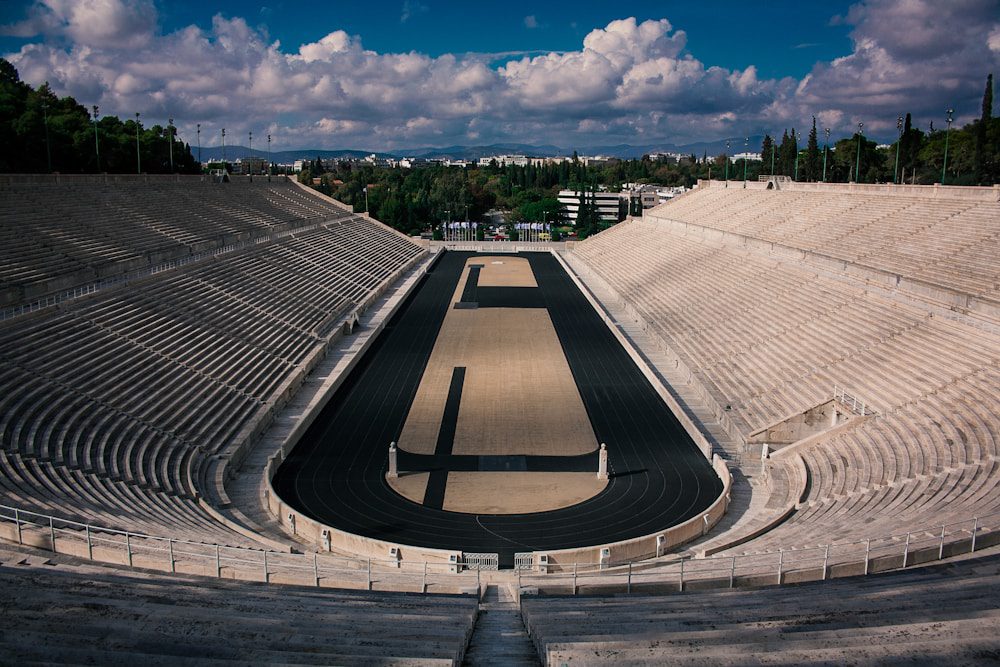
The Panathenaic Stadium, also known as the Kallimarmaro Stadium, is an ancient stadium located in Athens, Greece. Dating back to antiquity, the stadium was originally built in the 4th century BC for the Panathenaic Games, a religious and athletic festival held in honour of the goddess Athena. The stadium was rebuilt in marble by the Roman senator Herodes Atticus in 144 AD, giving it its distinctive white marble appearance. It is the only stadium in the world built entirely of marble and one of the oldest stadiums still in use today. The Panathenaic Stadium hosted the first modern Olympic Games in 1896, marking the revival of the ancient Olympic tradition. Today, the stadium serves as a historic and cultural landmark, as well as a venue for various sporting events and concerts.
Visitors to the Panathenaic Stadium can explore its well-preserved ancient architecture and learn about its fascinating history through guided tours and interactive exhibits. Practical tips for visiting the stadium include purchasing tickets in advance to avoid long lines, especially during peak tourist seasons. Visitors can also opt to take guided tours, which provide in-depth insights into the stadium’s history and significance. Additionally, the stadium offers breathtaking views of Athens from its highest tiers, making it an ideal spot for capturing memorable photos of the city skyline.
Athens National Garden
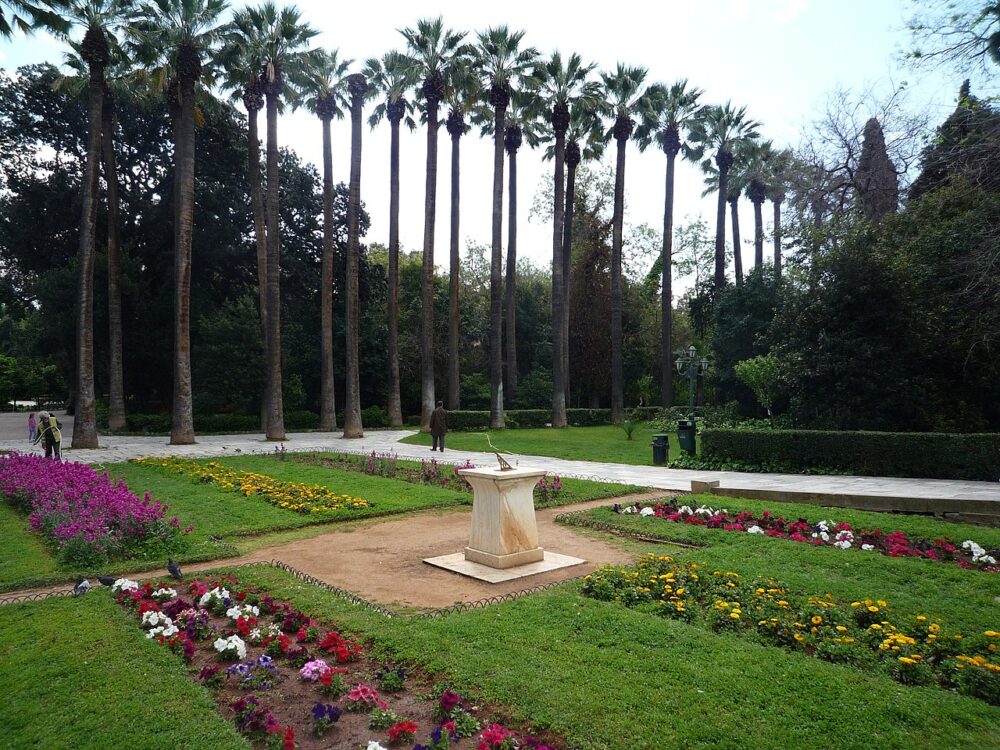
The Athens National Garden, also known as the Royal Garden, is a tranquil oasis located in the heart of Athens, Greece. It was commissioned by Queen Amalia in the 19th century as part of the Royal Palace complex and designed by the German agronomist Friedrich Schmidt. The garden spans over 15.5 hectares and is home to a diverse collection of flora, including trees, plants, and flowers from around the world. Visitors can explore winding paths, shady groves, and picturesque ponds, providing a peaceful escape from the bustling city streets. The garden also features neoclassical sculptures, ancient ruins, and charming pavilions, adding to its allure as a cultural and recreational destination.
Practical tips for visiting the Athens National Garden include wearing comfortable walking shoes and bringing along sunscreen and water, especially during the warmer months. The garden is open to the public year-round and offers free admission, making it an accessible attraction for both locals and tourists alike. Visitors can enjoy strolls, picnics, or simply relax on one of the many benches scattered throughout the garden. Additionally, guided tours are available for those interested in learning more about the garden’s history, plant species, and significance to Athens.
Syntagma Square
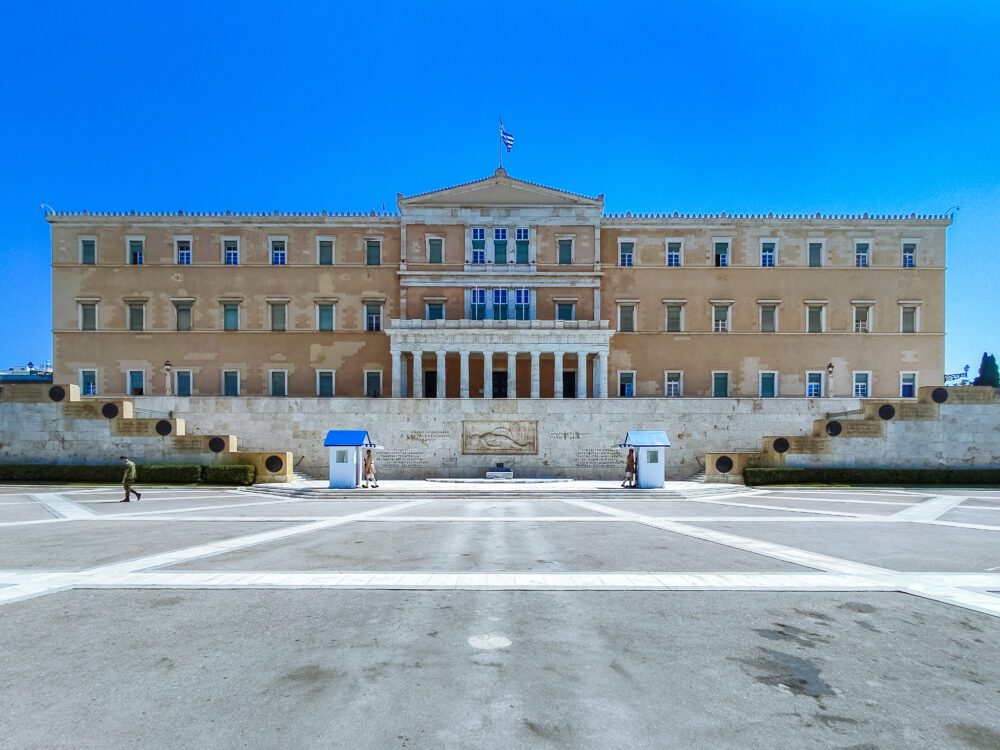
Syntagma Square, situated in the heart of Athens, holds great historical and cultural significance as the focal point of the city. Originally known as the Palace Square, it gained prominence in the 19th century when it became the site of the Royal Palace. Today, the square is flanked by important landmarks such as the Greek Parliament Building, the Tomb of the Unknown Soldier, and the luxurious Grande Bretagne Hotel. Syntagma Square serves as a bustling hub of activity, where locals and tourists converge to take in the sights, shop at nearby stores, or simply soak in the vibrant atmosphere.
Practical tips for visiting Syntagma Square include arriving early in the morning to avoid crowds and to witness the changing of the guard ceremony at the Tomb of the Unknown Soldier, which takes place every hour. Visitors can also explore nearby attractions such as the National Garden, the historic Plaka neighbourhood, and the upscale shopping district of Ermou Street. Additionally, Syntagma Square is well-connected by public transportation, with a metro station located directly beneath the square, making it easily accessible from various parts of the city.
Benaki Museum
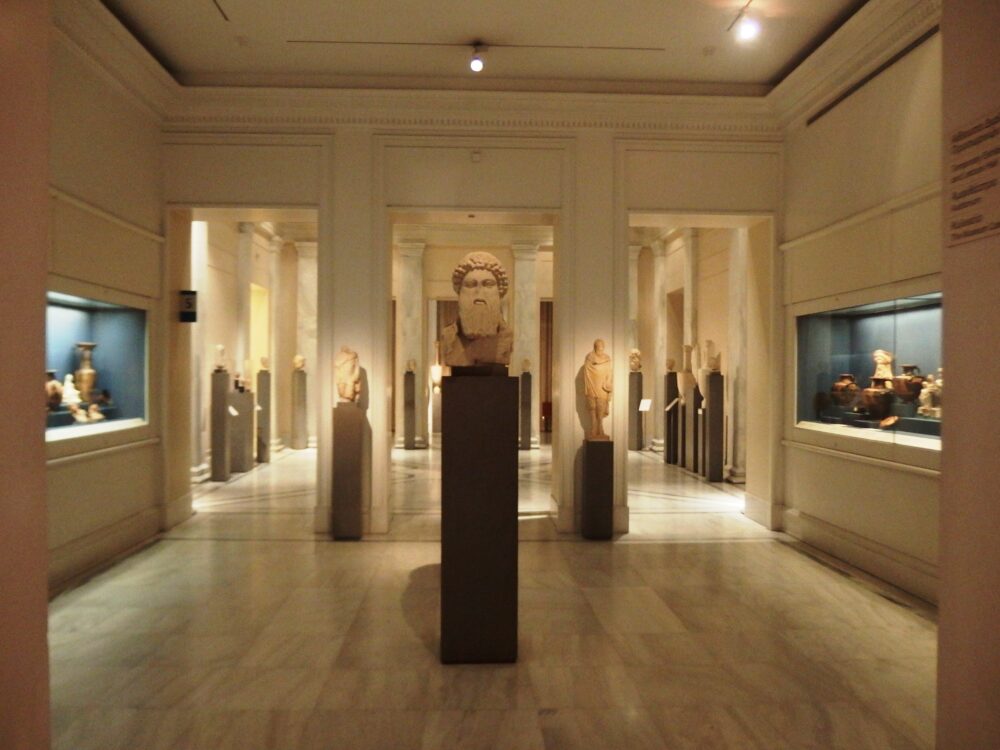
The Benaki Museum stands as a testament to Greece’s rich cultural heritage, housing an extensive collection of artefacts spanning thousands of years. Founded by Antonis Benakis in 1930, the museum began as a personal collection of Greek art and historical objects. Over the years, it has expanded significantly and now comprises several buildings across Athens, each dedicated to different periods of Greek history and art. The main building, located in the Kolonaki neighbourhood, showcases artefacts from prehistoric times to the modern era, offering visitors a comprehensive journey through Greece’s past.
Practical tips for visiting the Benaki Museum include planning your visit in advance to allocate enough time to explore its vast collection. Consider starting your tour at the main building and then venturing to other branches, such as the Benaki Museum of Islamic Art or the Benaki Museum of Greek Culture, depending on your interests. Additionally, the museum offers guided tours and educational programs for visitors of all ages, providing deeper insights into Greek history and art.
Lycabettus Hill

Lycabettus Hill, also known as Mount Lycabettus, is one of Athens’ most iconic landmarks, offering panoramic views of the city and the Aegean Sea from its summit, which stands at approximately 300 meters above sea level. According to Greek mythology, Lycabettus Hill was formed when the goddess Athena accidentally dropped a large rock she intended to use for the construction of the Acropolis. Over the centuries, the hill has been a site of religious significance and a strategic military outpost. Today, it is a popular destination for both locals and tourists seeking breathtaking views of Athens.
To reach the summit of Lycabettus Hill, visitors have several options. One can choose to hike up the winding paths that lead to the top, enjoying the lush greenery and stunning vistas along the way. Alternatively, there is a funicular railway that departs from the Kolonaki neighbourhood and takes passengers directly to the summit in just a few minutes. At the top, visitors can explore the tiny Chapel of St. George, enjoy refreshments at the hilltop café, or simply soak in the panoramic views of Athens, stretching all the way to the Saronic Gulf. Sunset is a particularly magical time to visit Lycabettus Hill, as the sky transforms into a palette of warm hues, casting a golden glow over the city below.
National Archaeological Museum
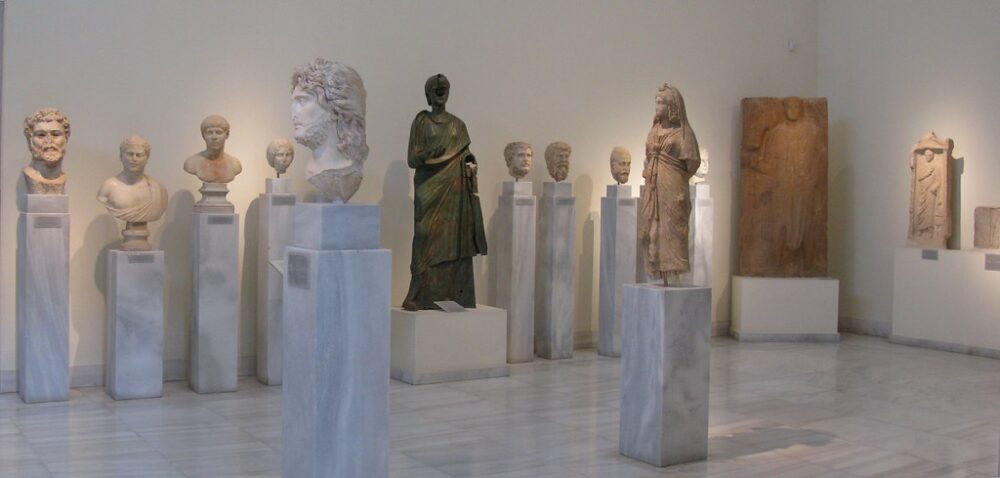
The National Archaeological Museum of Athens is one of the most important museums in Greece and a must-visit for anyone interested in ancient history and archaeology. Founded in the 19th century, the museum houses an extensive collection of artefacts from various periods of Greek history, spanning from prehistoric times to late antiquity. Its collection includes sculptures, pottery, jewellery, weapons, and other archaeological finds from excavations across Greece. One of the museum’s most famous exhibits is the Antikythera mechanism, an ancient Greek analogue computer used for astronomical calculations, considered one of the most significant archaeological discoveries of the 20th century.
Visitors to the National Archaeological Museum can explore its vast collection, which is organized into thematic sections showcasing different aspects of ancient Greek civilization. Highlights include the Mycenaean Gallery, featuring artefacts from the Bronze Age civilization of Mycenae; the Sculpture Gallery, displaying iconic sculptures such as the Artemision Bronze and the Poseidon of Artemisium; and the Treasury of Atreus, showcasing treasures from the royal tombs of Mycenae. Practical tips for visiting the museum include checking the opening hours and planning your visit to avoid crowds, as the museum can get busy, especially during peak tourist seasons.
Philopappos Hill
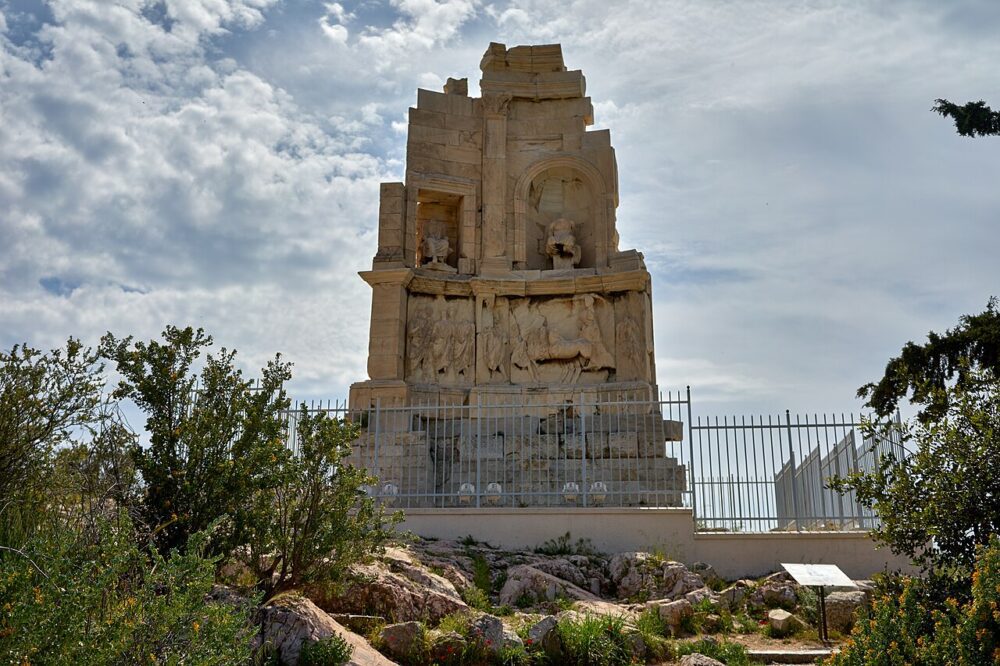
Philopappos Hill, also known as Philopappou Hill, is a prominent landmark in Athens offering breathtaking views of the city and its ancient monuments. Named after the prince and Roman consul Gaius Julius Antiochus Epiphanes Philopappos, who built a grand tomb on the hill in the 2nd century AD, Philopappos Hill is steeped in history and mythology. According to legend, it was here that the Greek playwright Euripides sought refuge and where Socrates was said to have addressed his followers. Today, the hill is a popular destination for both tourists and locals seeking panoramic vistas of Athens, including iconic landmarks such as the Acropolis, the Parthenon, and the Temple of Olympian Zeus.
Visitors can reach Philopappos Hill by following a scenic trail that winds its way up the hillside, passing through pine forests and ancient ruins along the way. The summit offers several vantage points where visitors can pause to admire the sweeping views of Athens and its surrounding landscapes. Sunset is a particularly magical time to visit, as the golden light bathes the city in a warm glow, creating a picturesque backdrop for photography enthusiasts. Practical tips for visiting Philopappos Hill include wearing comfortable walking shoes and bringing plenty of water, especially during the summer months when temperatures can soar.
Cape Sounion and Temple of Poseidon
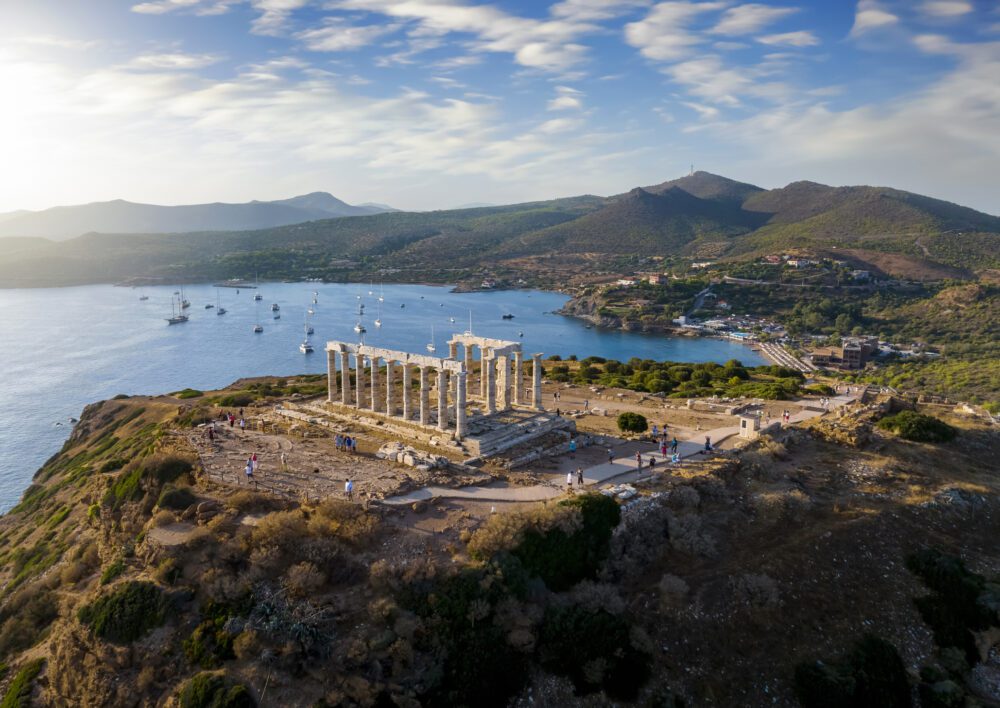
Cape Sounion, located about 70 kilometres southeast of Athens, is a stunning promontory overlooking the Aegean Sea, famous for its ancient ruins and the majestic Temple of Poseidon. Perched atop the cape’s rocky cliffs, the Temple of Poseidon is one of Greece’s most iconic archaeological sites, dating back to the 5th century BC. Dedicated to the god of the sea, Poseidon, the temple was built during the Golden Age of Athens and served as a beacon for sailors navigating the treacherous waters of the Saronic Gulf. Today, visitors can explore the temple’s Doric columns and marvel at its commanding position overlooking the sea.
Practical tips for visiting Cape Sounion and the Temple of Poseidon include planning your visit during the late afternoon to witness the breathtaking sunset over the Aegean Sea, casting a golden glow over the ancient ruins. It’s also advisable to wear sturdy footwear, as the terrain around the temple can be rocky and uneven. Additionally, consider bringing sunscreen, a hat, and plenty of water, especially during the summer months when temperatures can be high. Visitors can reach Cape Sounion by car or bus from Athens, and guided tours are also available for those who prefer a more informative experience. After exploring the temple, take some time to relax on the nearby beaches or enjoy a meal at one of the local tavernas, savouring fresh seafood dishes while soaking in the panoramic views of the Aegean coastline.
Greek Island Cruise
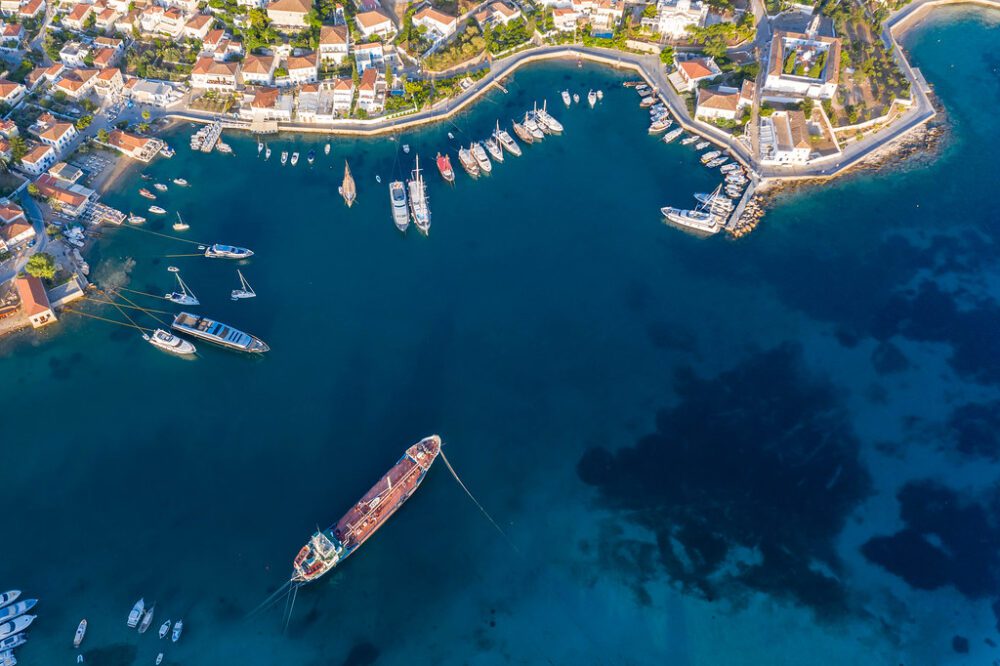
A Greek island cruise offers a unique opportunity to explore the stunning beauty and rich history of the Greek islands, each with its own distinct character and charm. From the cosmopolitan vibes of Mykonos to the romantic sunsets of Santorini and the historical treasures of Rhodes and Crete, there’s something for every traveller to discover. These islands have been inhabited since ancient times, with a fascinating history that includes stories of gods and goddesses, conquerors and traders, and centuries of cultural exchange and influence. Cruising around the Greek islands allows you to immerse yourself in this history while enjoying the breathtaking natural landscapes and crystal-clear waters of the Aegean and Ionian Seas.
Practical tips for a Greek island cruise include choosing the right itinerary based on your interests and preferences, whether you’re seeking relaxation, adventure, or cultural experiences. Consider booking a cruise that includes guided shore excursions to key historical sites and attractions, such as the Palace of Knossos in Crete, the Acropolis of Lindos in Rhodes, or the archaeological site of Akrotiri in Santorini. Pack comfortable clothing and footwear for exploring onshore, as well as swimwear and sunscreen for enjoying the beautiful beaches and swimming opportunities along the way. Keep in mind that weather conditions can vary depending on the time of year, so it’s a good idea to check the forecast and pack accordingly.
Conclusion
Exploring Athens is like delving into the cradle of Western civilization, where ancient history mingles effortlessly with modern life. From the majestic Acropolis to the bustling streets of Monastiraki and the serene beauty of the National Garden, Athens offers a plethora of experiences that cater to every traveller’s interests. Whether you’re a history buff, a food enthusiast, or simply seeking to immerse yourself in the vibrant culture of Greece, Athens has something to offer. The city’s rich history, stunning architecture, delicious cuisine, and warm hospitality make it a must-visit destination for anyone looking to experience the essence of Greece.
As you bid farewell to Athens, you’ll carry with you memories of iconic landmarks, delicious flavours, and the warmth of Greek hospitality. Whether you’ve marvelled at the Parthenon, wandered through the winding streets of Plaka, or savoured a sunset overlooking the Aegean Sea, Athens leaves an indelible mark on your heart and soul. As you reflect on your time in this ancient city, you’ll come to appreciate the timeless allure of Athens and the enduring legacy of its historical and cultural treasures.
